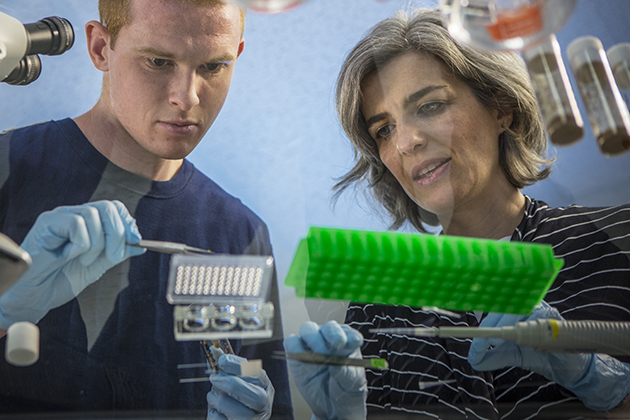Researchers from UConn and other institutions in the U.S. and abroad have shown how a relatively young gene can acquire a new function and become essential to an organism’s life.
Using a combination of techniques, including phylogenetics, molecular biology, and video microscopy, the scientists show that a novel essential gene in fruit flies, born via the process of gene duplication is only – yes, only – 15 million years old, and yet has acquired, in a stepwise fashion, a new job so important that the flies can’t live without it. The study, “Stepwise Evolution of Essential Centromere Function in a Drosophila Neogene,” is published in the June 6 edition of the journal Science.

“The majority of these genes are not going to acquire essential functions,” says Barbara Mellone, assistant professor of molecular and cell biology in UConn’s College of Liberal Arts and Sciences, of genes that, like the one they studied, have been duplicated. “But the interaction network is completely rewired for this gene.”
Mellone and colleagues at the University of Washington, the Fred Hutchinson Cancer Research Center in Seattle, and the University of Munich traced the evolutionary steps by which a gene from the well-known fruit fly Drosophila melanogaster, known as Umbrea, acquired its essential role. The gene is vital to chromosome segregation, the process of splitting genetic material when cells divide to generate more cells, tissues, and organisms.
“The genus Drosophila offers an unprecedented system in which to study gene evolution because of the detailed evolutionary and genomic data available,” says Mellone. “Learning about how new genes acquire new functions is crucial to understanding how whole genomes undergo functional innovation, which is what is needed for new traits to appear in populations that natural selection can act upon.”
What puzzled the scientists is that Umbrea plays the role of strengthening the connections between chromosomes, making sure that chromosome segregation happens correctly. And although it is also present in other species of fruit fly, it’s not essential in all of them. How then could a gene that has only been around for a fraction of this species’ history have acquired such an essential role?

To understand this paradox, the researchers used gene sequencing to understand the gene’s history and captured video of cells with Umbrea removed dividing under a microscope in Mellone’s laboratory. Their methods showed that after its birth Umbrea was lost in some of the species, but in one species, Drosophila melanogaster, cells without it failed to segregate chromosomes correctly, confirming its critical role.
But their results also showed that several stepwise changes led to Umbrea’s current-day time in the limelight: it lost its previous, nonessential function; the network of proteins it interacts with was completely rewired, and it acquired new, “tail” domains on the ends of its sequence that allowed it to relocate to the centromere, a structure present on all chromosomes in all species, necessary for genome segregation during cell division.
“This gene emerged and wasn’t going either way, toward or away from essential function,” says Mellone. “Then something happened elsewhere to help make it essential.”
The researchers argue that although most duplicated genes either become non-functional or are simply lost, keeping some of them around might benefit cells in the long run.
“Centromere proteins experience rapid evolution in many organisms, including humans, in a constant ‘arms race’ that exists to maintain the equal segregation of genetic traits,” says Mellone.
So if the genes involved in genome partitioning are evolving so fast, then perhaps it’s a good idea to keep other, nonfunctional genes around – those that can acquire new essential functions when necessary.
The scientists suggest that this could change the way scientists think about other biological processes that may require recurrent genetic innovation to adapt to new challenges.
To see a video of fruit fly cell division, visit Cell Life, Cell Death



